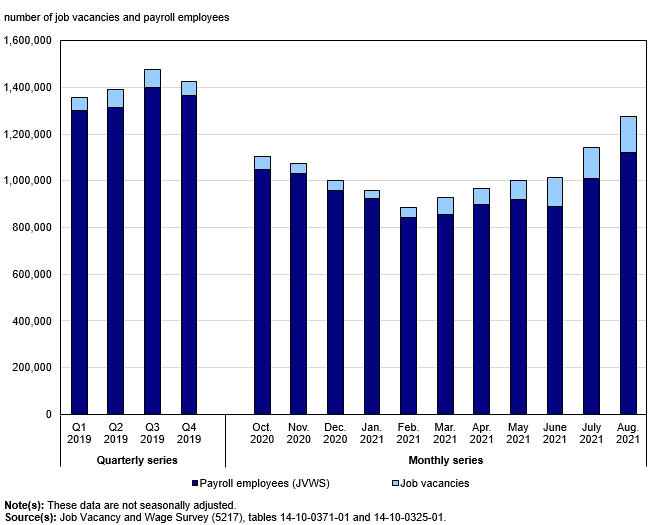Payroll employment, earnings and hours, and job vacancies, August 2021
Archived Content
Information identified as archived is provided for reference, research or recordkeeping purposes. It is not subject to the Government of Canada Web Standards and has not been altered or updated since it was archived. Please "contact us" to request a format other than those available.
Released: 2021-10-28
$1,138.00
August 2021
2.6% 
(12-month change)
$1,129.41
August 2021
2.0% 
(12-month change)
$949.66
August 2021
-1.2% 
(12-month change)
$981.14
August 2021
1.4% 
(12-month change)
$1,009.72
August 2021
1.3% 
(12-month change)
$1,074.36
August 2021
2.1% 
(12-month change)
$1,175.12
August 2021
2.2% 
(12-month change)
$1,024.40
August 2021
3.6% 
(12-month change)
$1,116.10
August 2021
0.9% 
(12-month change)
$1,221.50
August 2021
1.4% 
(12-month change)
$1,143.62
August 2021
5.0% 
(12-month change)
$1,353.99
August 2021
5.3% 
(12-month change)
$1,511.68
August 2021
-1.0% 
(12-month change)
$1,536.07
August 2021
6.2% 
(12-month change)
Payroll employment increased by 59,700 (+0.4%) in August, driven by gains in the services-producing sector in Ontario and Quebec.
By August, all jurisdictions in Canada had implemented the final or near-final stages of their public health reopening plans, meaning indoor locations—such as restaurants, recreation facilities, personal care services, retail stores, and entertainment venues—were generally permitted to be open, with varying degrees of capacity restrictions.
Payroll employment increases in half the provinces in August, led by Ontario and Quebec
The number of employees receiving pay or benefits from their employer—measured in the Survey of Employment, Payrolls and Hours (SEPH) as payroll employment—rose by 59,700 (+0.4%) in August, the third consecutive monthly increase. Compared with February 2020, payroll employment was down 362,500 (-2.1%) in August 2021.
Payroll employment increased in three provinces in August: Ontario (+26,900; +0.4%), Quebec (+20,800; +0.5%), and Alberta (+12,200; +0.6%). At the same time, payroll employment declined in New Brunswick (-2,300; -0.7%) and Prince Edward Island (-700; -1.0%). Despite the decline in August, New Brunswick was the sole province where payroll employment in August was above its pre-COVID-19 level (+5,100; +1.6%).
August payroll employment gains were driven by the services-producing sector in Ontario and Quebec. Nationally, payroll employment in the services-producing sector was down 332,800 (-2.4%) from February 2020. In the goods-producing sector, payroll employment increased by 11,400 in August 2021 (+0.4%), driven by construction (+5,800; +0.6%) and manufacturing (+5,000; +0.3%). This was the third consecutive monthly increase in payroll employment in the goods-producing sector, bringing it to 1.0% below its pre-COVID level.
Accommodation and food services continue to lead payroll employment gains
Payroll employment in accommodation and food services increased by 56,700 (+5.3%) in August, with gains in every province. Effective August 9, fully vaccinated non-essential travellers from the United States were permitted to enter Canada without quarantine requirements, potentially expanding tourism activity, including in food and accommodation businesses.
Full-service restaurants and limited-service eating places (+36,900; +4.3%) accounted for nearly two-thirds of the payroll employment increase in this sector in August. There were also notable gains in traveller accommodation (+12,700; +10.8%), special food services (+4,600; +10.1%) and drinking places (+2,500; +9.6%).
While accommodation and food services had the largest monthly payroll employment increase among all sectors in August, the pace of growth slowed compared with June (+80,900; +9.1%) and July (+97,200; +10.0%). In August, payroll employment in the sector was 16.5% below its February 2020 pre-pandemic level. In comparison, in August 2020, employment in the accommodation and food services sector was 28.8% below its pre-pandemic level.
Payroll employment in arts, entertainment and recreation increases in every province
Payroll employment in arts, entertainment and recreation increased for the third consecutive month, up by 23,700 (+10.6%) in August. This brought the total increase in the sector from May to August to 68,400 (+38.1%), as all jurisdictions continued to ease or lift public health restrictions on indoor and outdoor entertainment facilities throughout the summer.
All three subsectors saw payroll employment gains in August. Amusement, gambling and recreation industries (+16,600; +10.1%) had the largest increase, followed by performing arts, spectator sports and related industries (+5,400; +14.5%) and heritage institutions (+1,600; +7.1%).
Payroll employment in arts, entertainment and recreation increased in all provinces in August. Ontario (+11,000; +14.1%) accounted for nearly half of the increase, as provincial public health restrictions were further eased, allowing indoor concert venues, sports, recreation and fitness facilities, casinos/bingo halls, museums, galleries, historic sites and other arts, entertainment and recreation facilities to reopen.
Despite the recent upward trend, payroll employment in arts, entertainment and recreation was 66,800 (-21.2%) below its February 2020 level. Payroll employment in other amusement and recreation industries (-26,800; -15.8%) was furthest below its pre-pandemic level, followed by gambling industries (-12,200; -29.3%) and promoters (presenters) of performing arts, sports and similar events (-10,200; -37.1%).
Payroll employment growth continues in professional, scientific and technical services
In August, payroll employment increased by 5,800 (+0.6%) in professional, scientific and technical services, one of the sectors least affected by public health measures since the onset of the pandemic. The gain was spread across nearly all industries, with the largest increases seen in computer systems design and related services (+2,300; +0.8%) and architectural, engineering and related services (+2,100; +1.0%).
Compared with February 2020, payroll employment in the sector has increased 7.2%. Computer systems design and related services was the furthest above its pre-pandemic level (+34,700; +12.8%), followed by accounting, tax preparation, bookkeeping and payroll services (+12,500; +10.7%). Advertising, public relations, and related services was the lone industry in professional, scientific and technical services below its February 2020 level (-2,200; -4.1%) in August.
Average weekly earnings continue to increase nationally
Average weekly earnings increased by 0.7% in August to $1,138. Earnings were up in three provinces: Newfoundland and Labrador (+2.2% to $1,129), Quebec (+2.0% to $1,074) and Ontario (+1.0% to $1,175). Newfoundland and Labrador's average weekly earnings increase in August was driven by the construction sector (+14.5% to $1,559). At the same time, average weekly earnings were down 0.8% to $1,222 in Alberta.
Average hours worked down in August
Average hours worked were down 0.3% from July to 33.4 hours per week in August. Hourly paid employees worked an average of 31.0 hours per week, down 0.6% from July. Salaried employees worked an average of 37.1 hours per week, down 0.3% from July. Despite this decline, average hours worked were 1.2% above their pre-COVID level.
Job vacancies continue to be high entering August
The number of job vacancies remained above pre-COVID levels in a number of sectors in August, led by accommodation and food services, and health care and social assistance.
In total, there were an estimated 871,600 job vacancies at the start of August. While high job vacancies can be an indicator of growing employment, they can also be a signal of high turnover, labour shortages or mismatches between the characteristics of vacant positions and those of available workers. The job vacancy rate, which measures vacant positions as a proportion of all positions (vacant and occupied), was 5.2% in August. Since October 2020, this rate had ranged from 3.0% in December 2020 to 4.9% in June 2021 (data from the Job Vacancy and Wage Survey [JVWS] are unadjusted for seasonality).
Accommodation and food services continues to face a high number of job vacancies
Employers in accommodation and food services were actively recruiting for an estimated 156,800 job vacancies in August. In comparison, in the third quarter (July to September) of 2019, there were 76,600 vacancies in the sector. The job vacancy rate was 12.3% in August 2021, as job vacancies reached an all-time high, while employment in the sector remained 16.5% (-220,900) below its pre-COVID level (SEPH, seasonally adjusted).
Over the summer of 2021, job vacancies in accommodation and food services reached record-high levels, while payroll employment in the sector continued to recover following the easing of public health restrictions. This was likely the result of several factors, including staffing challenges associated with the resumption of business activity in the sector. In addition, the increase in vacancies was likely due in part to seasonal patterns, as labour demand in the sector typically peaks during the summer, and declines in autumn.
Results from the Canadian Survey on Business Conditions for the third quarter of 2021 showed that more than half (55.3%) of businesses in accommodation and food services expected the recruiting of skilled employees to be an obstacle—higher than the average for all businesses (34.6%). Likewise, the proportion of business locations in accommodation and food services that reported at least one vacancy was higher in August (42%) than prior to COVID-19 (30% in the third quarter of 2019).
Job vacancies remain high in health care and social assistance
Health care and social assistance continued to have a high number of vacancies in August (121,300), nearly twice as many as in the third quarter of 2019 (66,100).
Prior to COVID-19, payroll employment (based on the SEPH, seasonally adjusted) in health care and social assistance had been on a long-term upward trend, in line with population aging. Following the initial COVID-19 economic shutdown, employment in the sector reached a recent low in May 2020, before trending up and surpassing pre-COVID levels since February 2021.
Results from the quarterly JVWS showed that, of all occupations, job vacancies for registered nurses and registered psychiatric nurses increased the most in the second quarter of 2021 compared with two years earlier, and that nearly half (46.5%) of vacancies for this occupational group were open for 90 days or more.
Job vacancies reach a record high in professional, scientific and technical services
In professional, scientific and technical services—which includes computer and information systems professionals—vacancies reached a record high (61,100) in August, 66% higher than the number of vacancies in the third quarter of 2019 (36,800).
High number of vacancies in arts, entertainment and recreation as public health restrictions ease
In the arts, entertainment and recreation sector, both job vacancies (17,900) and the vacancy rate (6.3%) remained elevated in August. While vacancies in this sector—which includes operators and attendants in amusement, recreation and sport; and program leaders and instructors in recreation, sport and fitness—usually peak in the first and second quarters of the year, demand for labour was low in the first quarter of 2021 as public health restrictions affecting this sector had yet to ease. Job vacancies in arts, entertainment and recreation increased in April and have remained high into the third quarter of 2021 as public health restrictions have gradually loosened. Meanwhile, payroll employment has been increasing since June, but has remained further from its pre-COVID level than any other sector (-21.2%, SEPH seasonally adjusted).
Looking ahead
September data for SEPH and JVWS—to be released on November 25—will provide detailed information on subsectors and industries that may have been impacted by labour market developments, including continued vaccination efforts, rising COVID-19 cases, the start of a new school year, and the lifting of border restrictions for fully vaccinated international visitors on September 7.
Sustainable Development Goals
On January 1, 2016, the world officially began implementing the 2030 Agenda for Sustainable Development—the United Nations' transformative plan of action that addresses urgent global challenges over the following 15 years. The plan is based on 17 specific sustainable development goals.
The Survey of Employment, Payrolls and Hours is an example of how Statistics Canada supports reporting on the global sustainable development goals. This release will be used to measure the following goals:


Note to readers
Survey of Employment, Payrolls and Hours
The key objective of the Survey of Employment, Payrolls and Hours (SEPH) is to provide a monthly portrait of the level of earnings, employment and hours worked, by detailed industry, at the national, provincial and territorial levels.
Payroll employment, as measured by the SEPH, refers to the number of employees receiving pay or benefits (employment income) during a given month. The survey excludes the self-employed, owners and partners of unincorporated businesses and professional practices, and employees in the agricultural sector.
SEPH estimates are produced by integrating information from three sources: a census of approximately 1 million payroll deduction records provided by the Canada Revenue Agency; the Business Payrolls Survey, which collects data from a sample of 15,000 establishments; and administrative records of federal, provincial and territorial public administration employment, provided by these levels of government.
Estimates of average weekly earnings and hours worked are based on a sample and are therefore subject to sampling variability. This analysis focuses on differences between estimates that are statistically significant at the 68% confidence level. Payroll employment estimates are based on a census of administrative records and are not subject to sampling variability.
With each release of SEPH data, data for the preceding month are revised. Users are encouraged to use the most up-to-date data available for each month.
Statistics Canada also produces employment estimates from its Labour Force Survey (LFS). The LFS is a monthly household survey, the main objective of which is to divide the working-age population into three mutually exclusive groups: the employed (including the self-employed), the unemployed and those not in the labour force. This survey is the official source for the unemployment rate, and it collects data on the sociodemographic characteristics of all those in the labour market.
As a result of conceptual and methodological differences, estimates of changes from the SEPH and the LFS differ occasionally. However, the trends in the data are similar. For a more in-depth discussion of the conceptual differences between employment measures from the LFS and the SEPH, refer to Section 8 of the Guide to the Survey of Employment, Payrolls and Hours (72-203-G).
Unless otherwise stated, this release presents seasonally adjusted data, which facilitate comparisons because the effects of seasonal variations are removed. For more information on seasonal adjustment, see Seasonally adjusted data – Frequently asked questions.
Non-farm payroll employment data are for all hourly and salaried employees and for the "other employees" category, which includes piece-rate and commission-only employees.
Unless otherwise specified, average weekly hours data are for hourly and salaried employees only and exclude businesses that could not be classified to a North American Industry Classification System (NAICS) code.
All earnings data include overtime and exclude businesses that could not be classified to a NAICS code. Earnings data are based on gross taxable payroll before source deductions. Average weekly earnings are derived by dividing total weekly earnings by the number of employees.
Job Vacancy and Wage Survey
Beginning with the release of October 2020 data, preliminary monthly estimates from the Job Vacancy and Wage Survey (JVWS) are published on a monthly basis. These estimates provide more timely information on the number of job vacancies and the job vacancy rate by province and by industrial sector.
JVWS collection is done on a quarterly basis. The quarterly sample of business locations is allocated to the three collection months of the quarter, approximately balanced by province and by industrial sector across each of the three months. This allows both quarterly and monthly estimates to be produced.
The JVWS also provides comprehensive quarterly data on job vacancies by industrial sector and detailed occupation for Canada and the provinces, territories and economic regions; offered hourly wages; and job vacancy characteristics. Quarterly data for the second and third quarters of 2020 are unavailable because survey operations were temporarily suspended during the COVID-19 pandemic. More information about the concepts and use of data from the JVWS is available in the Guide to the Job Vacancy and Wage Survey (75-514-G).
Preliminary monthly estimates are produced for job vacancies, job vacancy rates and payroll employment using available responses from business locations sampled in the corresponding reference month. The reference period for the JVWS is the first day of the respective month.
These preliminary monthly estimates are revised and finalized when the corresponding quarterly estimates are released or shortly thereafter. Users are encouraged to use the most up-to-date data available for each month.
JVWS estimates are not seasonally adjusted. Therefore, month-to-month and quarter-to-quarter comparisons should be interpreted with caution as they may reflect seasonal movements.
While JVWS employment is calibrated to the SEPH, SEPH payroll employment and JVWS preliminary monthly employment figures may differ because of calibration grouping and differences in scope and reference period.
Real-time data tables
Real-time data tables 14-10-0357-01, 14-10-0358-01, 14-10-0331-01 and 14-10-0332-01 will be updated on November 15, 2021.
Next release
Data on payroll employment, earnings and hours, and job vacancies for September will be released on November 25, 2021.
Products
More information about the concepts and use of the Survey of Employment, Payrolls and Hours is available in the Guide to the Survey of Employment, Payrolls and Hours (72-203-G).
The product "Earnings and payroll employment in brief: Interactive app" (14200001) is now available. This interactive data visualization application provides a comprehensive picture of the Canadian labour market using the most recent data from the Survey of Employment, Payrolls and Hours. The estimates are seasonally adjusted and available by province and largest industrial sector. Historical estimates going back 10 years are also included. The interactive application allows users to quickly and easily explore and personalize the information presented. Combine multiple provinces and industrial sectors to create your own labour market domains of interest.
Contact information
For more information, or to enquire about the concepts, methods or data quality of this release, contact us (toll-free 1-800-263-1136; 514-283-8300; STATCAN.infostats-infostats.STATCAN@canada.ca) or Media Relations (613-951-4636; STATCAN.mediahotline-ligneinfomedias.STATCAN@canada.ca).
- Date modified:



